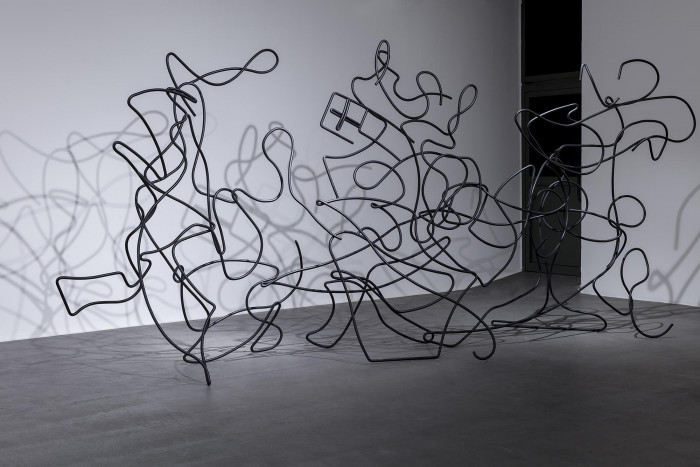A very happy story, and therefore very sad
2021, powder steel, 250 × 500 × 140 cm
2021, powder steel, 250 × 500 × 140 cm

A very happy story, and therefore very sad, installation view at Battlefield exhibition, Bielska BWA Gallery, Bielsko-Biała, Poland, 2021
in cooperation with Kasper Lecnim
Although one could swear that while talking about Poland, we always speak with Wyspiański, let’s be honest: we clearly look at Poland through the lenses of Matejko’s Battle of Grunwald – the ten by five metres of national triumph in oil on canvas. Although “you need shoes to go to a wedding”, the vision of losing a golden horn has a lesser effect on patriotic feelings than a gigantic jumble of horses and people. Matejko and Wyspiański might have a lot in common, but they are definitely separated by a mental chasm. When young Wyspiański wants to flee to Paris, Matejko tells him “it is too early”, patting him on the back. When Matejko stares at a stuffed horse cluttering up his atelier, Wyspiański dabbles in everything, as befits one besotted with Arts & Crafts. When one of them attempts to preserve the sense of Polishness, the other one tries to criticise it with art. This tension gives rise to Wyspiański’s Battle – a modestly-sized sketch, a joke, a jibe against the gigantomania of his short-sighted master, whose beard still emanates the stuffiness of Kraków. And now, what if this joke were made spatial, enlarged, and – above all – taken seriously? What if Matejko were belittled, and Wyspiański – frivolously monumentalised? What if the curved pencil lines were turned into an arabesque of metal rods, casting its triumphant shadow on the wall? In this madness, any method is good for moving the foundations of the Polish old-school – a very happy story, and therefore very sad.
original Polish text by: Aleksy Wójtowicz

Stanisław Wyspiański, The Battle, c. 1900, c. 19 x 29 cm



Jan Matejko, Battle of Grunwald, 1872–1878, oil on canvas, 426 × 987 cm

A very happy story, and therefore very sad, installation view at Battlefield exhibition, Bielska BWA Gallery, Bielsko-Biała, Poland, 2021